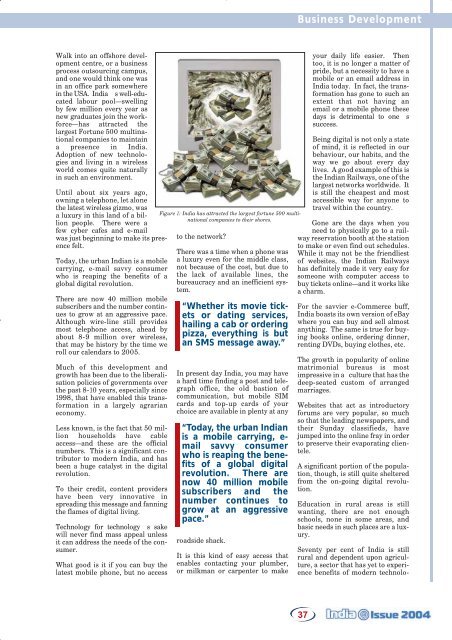Contents - Connect-World
Contents - Connect-World
Contents - Connect-World
You also want an ePaper? Increase the reach of your titles
YUMPU automatically turns print PDFs into web optimized ePapers that Google loves.
Business Development<br />
Walk into an offshore development<br />
centre, or a business<br />
process outsourcing campus,<br />
and one would think one was<br />
in an office park somewhere<br />
in the USA. Indias well-educated<br />
labour pool—swelling<br />
by few million every year as<br />
new graduates join the workforce—has<br />
attracted the<br />
largest Fortune 500 multinational<br />
companies to maintain<br />
a presence in India.<br />
Adoption of new technologies<br />
and living in a wireless<br />
world comes quite naturally<br />
in such an environment.<br />
Until about six years ago,<br />
owning a telephone, let alone<br />
the latest wireless gizmo, was<br />
a luxury in this land of a billion<br />
people. There were a<br />
few cyber cafes and e-mail<br />
was just beginning to make its presence<br />
felt.<br />
Today, the urban Indian is a mobile<br />
carrying, e-mail savvy consumer<br />
who is reaping the benefits of a<br />
global digital revolution.<br />
There are now 40 million mobile<br />
subscribers and the number continues<br />
to grow at an aggressive pace.<br />
Although wire-line still provides<br />
most telephone access, ahead by<br />
about 8-9 million over wireless,<br />
that may be history by the time we<br />
roll our calendars to 2005.<br />
Much of this development and<br />
growth has been due to the liberalisation<br />
policies of governments over<br />
the past 8-10 years, especially since<br />
1998, that have enabled this transformation<br />
in a largely agrarian<br />
economy.<br />
Less known, is the fact that 50 million<br />
households have cable<br />
access—and these are the official<br />
numbers. This is a significant contributor<br />
to modern India, and has<br />
been a huge catalyst in the digital<br />
revolution.<br />
To their credit, content providers<br />
have been very innovative in<br />
spreading this message and fanning<br />
the flames of digital living.<br />
Technology for technologys sake<br />
will never find mass appeal unless<br />
it can address the needs of the consumer.<br />
What good is it if you can buy the<br />
latest mobile phone, but no access<br />
Figure 1: India has attracted the largest fortune 500 multinational<br />
companies to their shores.<br />
to the network<br />
There was a time when a phone was<br />
a luxury even for the middle class,<br />
not because of the cost, but due to<br />
the lack of available lines, the<br />
bureaucracy and an inefficient system.<br />
“Whether its movie tickets<br />
or dating services,<br />
hailing a cab or ordering<br />
pizza, everything is but<br />
an SMS message away.”<br />
In present day India, you may have<br />
a hard time finding a post and telegraph<br />
office, the old bastion of<br />
communication, but mobile SIM<br />
cards and top-up cards of your<br />
choice are available in plenty at any<br />
“Today, the urban Indian<br />
is a mobile carrying, e-<br />
mail savvy consumer<br />
who is reaping the benefits<br />
of a global digital<br />
revolution. There are<br />
now 40 million mobile<br />
subscribers and the<br />
number continues to<br />
grow at an aggressive<br />
pace.”<br />
roadside shack.<br />
It is this kind of easy access that<br />
enables contacting your plumber,<br />
or milkman or carpenter to make<br />
your daily life easier. Then<br />
too, it is no longer a matter of<br />
pride, but a necessity to have a<br />
mobile or an email address in<br />
India today. In fact, the transformation<br />
has gone to such an<br />
extent that not having an<br />
email or a mobile phone these<br />
days is detrimental to ones<br />
success.<br />
Being digital is not only a state<br />
of mind, it is reflected in our<br />
behaviour, our habits, and the<br />
way we go about every day<br />
lives. A good example of this is<br />
the Indian Railways, one of the<br />
largest networks worldwide. It<br />
is still the cheapest and most<br />
accessible way for anyone to<br />
travel within the country.<br />
Gone are the days when you<br />
need to physically go to a railway<br />
reservation booth at the station<br />
to make or even find out schedules.<br />
While it may not be the friendliest<br />
of websites, the Indian Railways<br />
has definitely made it very easy for<br />
someone with computer access to<br />
buy tickets online—and it works like<br />
a charm.<br />
For the savvier e-Commerce buff,<br />
India boasts its own version of eBay<br />
where you can buy and sell almost<br />
anything. The same is true for buying<br />
books online, ordering dinner,<br />
renting DVDs, buying clothes, etc.<br />
The growth in popularity of online<br />
matrimonial bureaus is most<br />
impressive in a culture that has the<br />
deep-seated custom of arranged<br />
marriages.<br />
Websites that act as introductory<br />
forums are very popular, so much<br />
so that the leading newspapers, and<br />
their Sunday classifieds, have<br />
jumped into the online fray in order<br />
to preserve their evaporating clientele.<br />
A significant portion of the population,<br />
though, is still quite sheltered<br />
from the on-going digital revolution.<br />
Education in rural areas is still<br />
wanting, there are not enough<br />
schools, none in some areas, and<br />
basic needs in such places are a luxury.<br />
Seventy per cent of India is still<br />
rural and dependent upon agriculture,<br />
a sector that has yet to experience<br />
benefits of modern technolo-<br />
37
















